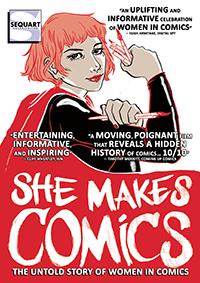I can’t be the only person on this planet who finds She-Hulk sexy. That combination of va-va-voom curves, strength and intelligence (the last is important) is a hugely attractive blend. So, the only question is really, is that a good thing or not? Does the fact that I, and I suspect millions of men and women all over this big world, find She-Hulk to be a bit of a female fantasy figure makes us sexist? Does it make the creators sexist for exploiting this character for potentially erotic means?
The debate that’s broken out between David S. Goyer and Stan Lee over this issue this week is instructive, from a feminist point of view, about where superhero comics are in this new century. Goyer, a person of my generation who no doubt received the same excellent feminist education I did in film school, looks at She-Hulk and sees a figure that is obviously an expression of a male sexual fantasy. She wears ripped clothes that reveal her legs, butt and bust, she’s lustful and powerful in a way that corresponds closer to the world of the stripper than the superhero. She’s obviously designed to appeal to those who like that sort of thing, an object, in old-fashioned feminist terms, to serve the male Gaze. “A giant, green porn star,” to quote him exactly. Lee, from an entirely different generation with different assumptions about normative gender representation and behaviour, sees She-Hulk as empowering because she is intelligent in a way that her male counterpart is not, and showing that a woman could be smart, muscular and sexy, to him, is the very definition of feminist empowerment.
My take on it is that they’re both right, and they’re both wrong. We’re at an odd time in our culture with regards to gender, and this is an example of how that discussion, and how that dance that us humans do with each other around sex, is evolving. Stan Lee is exactly right to point out that, especially the 1970s and even today, you don’t see much in the way of a strong, single, intelligent and capable female comic book hero. The pool is rather small, when compared to the male contingent. His defence of the exaggerated way in which she’s drawn is simply to say to “show me the superheroine who isn’t.” Point taken, although probably not in the way Mr. Lee intended. Obviously comic book superheroes are drawn to a physical ideal, male and female. It’s been demonstrated pretty convincingly, though, that female superheroes are drawn in much more sexualized poses (such as the infamous “brokeback” pose) than their male counterparts. That simply means that these comics are still drawn by and for the “male Gaze” (which, of course, is a theoretical term that includes anyone who might be turned on by a sexualized female form). This particular genre of comics, the superhero, is problematic and probably always will be in that way. But the She-Hulk is no worse than the others, and better in many ways.
One of Goyer’s assertions that truly falls flat is that the She-Hulk was designed to be “the Hulk’s boyfriend”. Not a chance: Lee created her as Bruce Banner’s cousin specifically because he didn’t want any relationship between them. “Only a nut would even think of that,” Stan the Man said this week. This is Goyer’s presumption, and you can see it frankly in his screen writing, that any two figures of the opposite sex that have comparable appearance and abilities are obliged to be lovers. Perhaps in a formulaic and factory-written Hollywood script, but not in real life, and, to Stan Lee’s credit, not in the comics.
But Goyer does voice a legitimate concern for feminist fans of superhero comics. I wrote an article earlier this week about how Kitty Pryde is the true protagonist of Days of Future Past. (And Kitty, by the way, is NOT drawn in a sexual way at all, but rather as a slight, thin woman not particularly conventionally attractive.) But she’s the exception, and Hollywood, obviously given how they’ve mangled the story for the upcoming film adaptation, still can’t seem to handle a strong female superhero. Their instincts just can’t seem to understand why a female hero wouldn’t need a boyfriend (because, as their thinking no doubt goes, “that’s what girls come to the theatre to see”), or why she can’t be something less than a bombshell (again, because they probably think, “that’s what boys go to the theatre to see”). So, while films languish in sexism and dinosaur-level thinking, comics take risks and give us She-Hulk, with all her power and sexiness and say, “deal with it”. If Goyer finds that exploitative, it’s a very weak sort of exploitation compared to what happens in his industry. And if Stan Lee finds it empowering and defends his creation, more power to him. Let’s hope all of us are as enlightened as him in our nineties.




















































